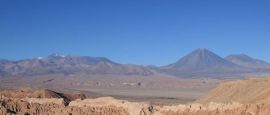Chile Weather, climate and geography
Weather & climate
Due to its long coastline, clearly Chile’s weather is extremely diverse and unpredictable although it is seasonal in much of the country. Summer runs from December to February, and winter from June to August.
It is difficult to pinpoint temperatures ranges for the country as a whole as they’re so variable. There’s the dry, arid Atacama desert in the north where temperatures reach a maximum of 32°C (90°F) and can drop to -2°C (28°F). Chile’s central region has a Mediterranean feel with a cold, wet season from May to August, while it is usually always cool and damp in the south. Easter Island has its own humid sub-tropical temperatures, while much of the south, from Region VII down has a very high annual rainfall.
Arica, Iquique, Antofagasta, La Serena and Coquimbo are the principal summer beach hubs in the north for local tourists, while Pucón in the south sees high tourism numbers from January to March. Due to its proximity to Santiago, Viña del Mar and Valparaíso beach areas see plenty of sunshine and beach bums during the summer, often filling up with neighbouring Argentinians. As Chile is in the southern hemisphere, the ski season takes place between June and August.
In terms of visiting Patagonia and south, the summer months from December to March are ideal as it is warmer for trekking and other outdoor activities. November and April are quieter times in terms of tourism but the weather is less dependable. It isn’t advisable to visit the south from the end of autumn to the end of winter - May to September - as many trails close due to bad weather and strong winds and waterways ice over. However, places in the north, such as the Atacama, can be visited all year round.
If visiting the cities, bring lightweight, natural fabrics that can wick away sweat easily. During the wet season, you’ll need to bring waterproofs – aim for breathable materials so you don’t overheat. More substantial waterproofs and warm weather clothing are often needed in the south and at altitude.
Geography
Chile is situated in South America, bordered to the north by Peru, to the east by Bolivia and Argentina, to the west by the Pacific Ocean and to the south by the Antarctic. The country exercises sovereignty over a number of islands off the coast, including the Juan Fernández Islands and Easter Island. Chile is 4,329km (2,690 miles) long and nowhere more than 180km (112 miles) wide.
The Andes and a more westerly coastal highland range run parallel with each other for much of the country's length. The coastal range forms high, sloped cliffs into the sea from the northern to the central area. Between the ranges runs a fertile valley, except in the north where transverse ranges join the two major ones, and in the far south where the sea has broken through the coastal range to form an assortment of archipelagos and channels.
Wide variations in soil and a vast difference in climate are reflected in an uneven population distribution, and in a wide range of occupations. The Atacama desert, the driest in the world, is in the northern part of the country, which is also the main mining area. The central zone is predominantly agricultural, and is often referred to as the breadbasket of Chile. This is where the two-thirds of the population reside. Below Concepción, there are large tracts of forested land, although the area also has some agriculture. Chile is prone to frequent powerful earthquakes as the Liquine-Ofqui Fault lies just under the northern Patagonian Andes and runs for 1000km (621 miles).
Do you have any Feedback about this page?
© 2025 Columbus Travel Media Ltd. All rights reserved. No part of this site may be reproduced without our written permission, click here for information on Columbus Content Solutions.




 You know where
You know where